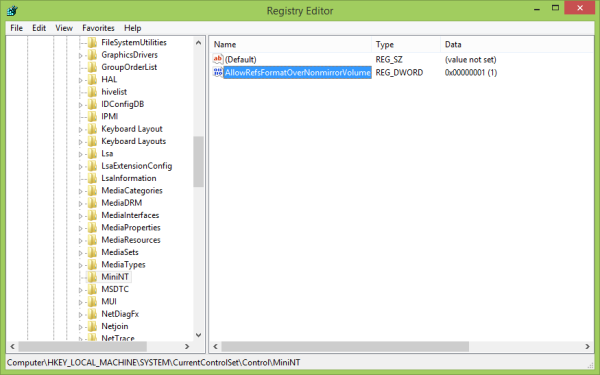Windows 8 (or rather Windows Server 2012) introduced a new file system called ReFS. ReFS stands for Resilient File System. Codenamed "Protogon", it improves on NTFS in some respects, while also removing a number of features. You may read about the advantages of ReFS in the following Wikipedia article. ReFS is intended for file servers only. In Windows 8.1, it is in fact locked for server OS only. If you need to unlock and enable full read and write support for ReFS in Windows 8.1, you can follow these simple instructions in this article.
Advertisеment
To enable support for ReFS,
- Open your registry editor (see how)
- Navigate to the following registry key:
HKEY_LOCAL_MACHINE\SYSTEM\CurrentControlSet\Control
Tip: you can access the desired Registry key with one click.
- Create here a new key called MiniNT to get the following path:
HKEY_LOCAL_MACHINE\SYSTEM\CurrentControlSet\Control\MiniNT
- Here, you should create a new DWORD value called "AllowRefsFormatOverNonmirrorVolume". The value data of this parameter must be 0 or 1. Set it to 1 to unlock the ReFS feature in Windows 8.1.

- Reboot your PC.
That's it. Now you will now be able to write to ReFS partitions, format new partitions in ReFS and so on.
Bonus tip: To create an ReFS-formatted drive, you can perform the following steps.
- Press Win+R keys on the keyboard. The "Run" dialog will appear on the screen.
- Type diskpart and press Enter. Confirm the User Account Control request.
- Select the disk you want to format with the following commands:
list disk sele disk 6 clean create part pri format fs=refs quick
Note: 6 is my disk number which I want to format with ReFS. You should specify the correct disk number depending on what you see after doing 'list disk'. Also note, this operation will remove everything from that drive.
If you have any questions, see the following video:
Thanks to our friends "moderate" and "khagaroth" @MDL for this tip...
Support us
Winaero greatly relies on your support. You can help the site keep bringing you interesting and useful content and software by using these options:

Is the version 8.1 released out??? Thanks for the tutorial
Correct, it is already available for MSDN subscribers.
Available now for everybody.
I use win 8.1 and i have added reg key.
I managed to create a ReFS without mirroring on 2 steps with Disk management : -> new simple volume -> assign drive letter -> do not format ->finish. + format (select ReFS).
However, it is not possible to do the same in storage space.
I have not tried this trick on the Storage spaces. I will look closely when I will get some more free time.
I found a problem with Event Log Viewer and Action Center fails to work correctly MiniNT key is present.
Therefore, should make this registry only when you want to format.
Fortunately, this registry is not needed for access to non-mirror ReFS volume.
Event Advanced Statup Options menu doesn’t work correctly. Only Icons are displayed, without any text
Self-healing NTFS is not working probably. ( `fsutil repair query` reports disabled, and cannot enable. )
Can’t run online chkdsk. ( chkdsk /scan )
Another issue with this registry tweak. After applying it, Windows Explorer showed I had 4 new drives G, H, I, and L all of them with 0 bytes.
Another item that does not work with this registry entry is System Restore! So after you have finished formatting delete the key.
ohh! I didn’t notice this
I did this whole operation without reboot using PowerShell (run as Administrator) in Windows 8.1.
Here’s the Storage Commandlet reference: http://technet.microsoft.com/en-us/library/hh848705.aspx
Standard disclaimer… change values below for your specific situation and if you break your computer, delete all your files, etc don’t blame me!
My setup… I have a storage pool with 8 drives called “Storage pool”, I wanted to create a thinly provisioned 50TB parity VirtualDisk called “Parity81” and put on it a ReFS partition with the drive letter “R:”… so for the love of god if you already have a “R” drive, don’t run this script unmodified because it will format it!
(create new virtual disk – this is 8 column with 1 drive parity – unfortunately I couldn’t get “-PhysicalDiskRedundancy 2” to work … is it server OS only perhaps?)
New-VirtualDisk -FriendlyName Parity81 -StoragePoolFriendlyName “Storage pool” -NumberOfColumns 8 -ProvisioningType Thin -ResiliencySettingName Parity -Size 50TB
(initialize the new disk)
Get-VirtualDisk -FriendlyName “Parity81” | Get-Disk | Initialize-Disk
(create the partition for ReFS – I got a popup box saying ‘do you want to format’ – I said ‘no’, ymmv)
Get-VirtualDisk -FriendlyName “Parity81” | Get-Disk | New-Partition -UseMaximumSize -DriveLetter R
(set registry key to let us format ReFS)
New-Item -Path HKLM:\SYSTEM\CurrentControlSet\Control\MiniNT
New-ItemProperty -Path HKLM:\SYSTEM\CurrentControlSet\Control\MiniNT -Name AllowRefsFormatOverNonmirrorVolume -PropertyType DWORD -Value 1
(format ReFS)
Format-Volume -DriveLetter R -FileSystem ReFS -NewFileSystemLabel ReFS -SetIntegrityStreams $True
(remove registry key again – careful, it will remove all keys in the MiniNT folder if there were others already there)
Remove-Item -Path HKLM:\SYSTEM\CurrentControlSet\Control\MiniNT
(I also set this because allegedly it makes things go faster but you can corrupt data if you’re not on a UPS and the power goes out)
Set-StoragePool -FriendlyName “Storage pool” -IsPowerProtected $true
Anyway… thanks for finding the registry key :)
Do that and you’r basically telling the OS that it is a PE environment (MiniNT). Stuff will start to fail randomly… try “reagent /boottore” and check what happens… :)
This is a horrible idea! “nmam” is right…by making the OS think it is in a PE environment, the following things fail:
1. System restore
2. Event viewer
3. Ability to upgrade Windows